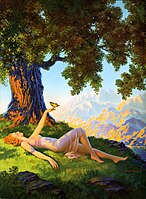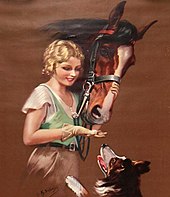Brown & Bigelow
44°56′29″N 93°4′28″W / 44.94139°N 93.07444°W
| Founded | 1896 |
|---|---|
| Country of origin | United States |
| Headquarters location | 345 Plato Boulevard East, St. Paul, Minnesota 55107 |
| Official website | www |
Brown & Bigelow is a publishing company based in Saint Paul, Minnesota, that sells branded apparel and promotional merchandise.
History


The company was founded in 1896 by Herbert Huse Bigelow and Hiram Brown.
On June 24, 1924, Bigelow was convicted for tax evasion, fined ten thousand dollars, and sentenced to three years in Leavenworth Penitentiary.[1] He was released after eight months. While incarcerated, he befriended infamous safe-cracker Morris Rudensky.[2]
On April 13, 1928, President Calvin Coolidge pardoned Bigelow.[3] Following Bigelow's release, the company became notable for developing prototype convict rehabilitation programs through the hiring of hundreds of ex-convicts.[citation needed]
Products
In 1925 Brown & Bigelow inaugurated a tradition of publishing calendars for the Boy Scouts of America, many of which were illustrated by Norman Rockwell.[citation needed] In 1936 then president Charlie Ward paid ten thousand dollars to Maxfield Parrish for exclusive rights to his work Peaceful Valley.[4] By the late 1940s, the company was one of the largest printers of calendars in the world,[5] employing some of the best pin-up artists in the United States and putting calendars into an estimated fifty million homes.[6]
Rockwell agreed to paint a self-portrait for the 1969 edition of the Boy Scouts of America calendar as a tribute to his seventy-fifth birthday.[7]
The company has published artworks by Cassius Marcellus Coolidge (his sixteen-painting Dogs Playing Poker series), Rolf Armstrong, Gil Elvgren, Earl Moran, Vaughn Alden Bass, Mabel Rollins Harris, Douglass Crockwell, Norman Rockwell and Zoë Mozert.[citation needed]
Gallery
-
"Golden Glory" by Edward Mason Eggleston. 1929 Tintogravure print.
-
“The Treasure Princess” by Edward Mason Eggleston. 1932 Tintogravure print.
-
"A Day in June", by Edward Mason Eggleston. 1932 Tintogravure print.
-
"Comrades All", by Henry Hintermeister or John Henry Hintermeister. From 1923 calendar.
-
Thoroughbreds by Henry or John Henry Hintermeister.
References
- ^ "Herbert H. Bigelow". bigelowsociety.com. Retrieved 2018-12-07.
- ^ Folkart, Burt A. (1988-04-23). "Former Cellmate of Al Capone : Morris (Red) Rudensky; Criminal Turned Author". Los Angeles Times.
- ^ Ruckman, P. S.; Jr. "Quite the Pair: Herbert H. Bigelow and Charlie Ward". Retrieved 2018-12-07.
- ^ "Archived copy". Archived from the original on 2011-05-04. Retrieved 2011-02-20.
{{cite web}}: CS1 maint: archived copy as title (link) - ^ Berger, Warren (January 2001). "Schwag Bag". Wired. 9 (01). Retrieved 2006-08-13.
- ^ "Great Moments in Schwag History". Wired. 9 (01). January 2001. Retrieved 2006-08-13.
- ^ William Hillcourt (1977). Norman Rockwell's World of Scouting. New York: Harry N. Abrams. ISBN 0-8109-1582-0.





